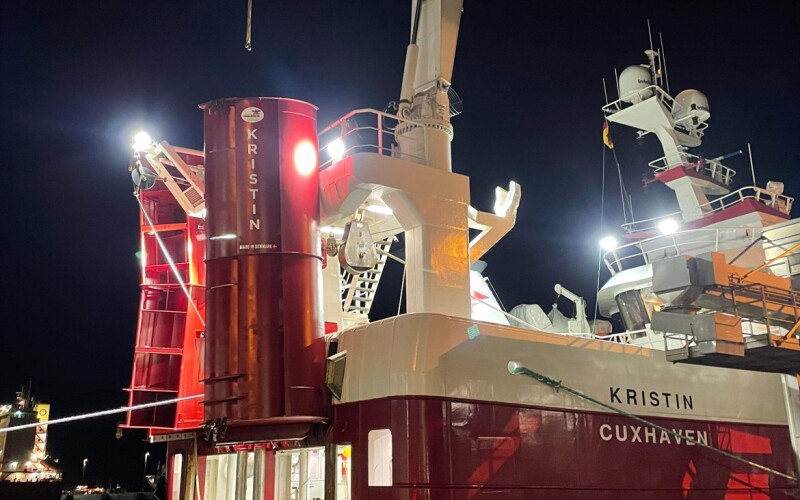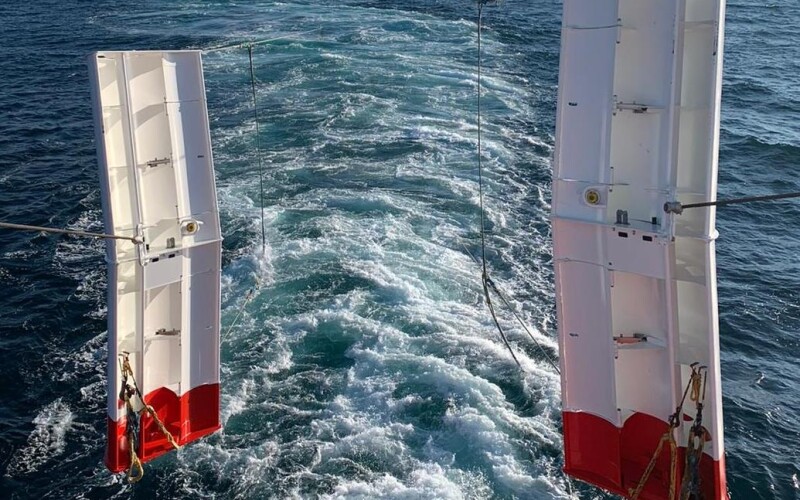Thyborøn, a Danish company, introduces fully controllable doors for midwater trawlers. Trawl doors, long sought after by captains for their ability to be controlled from the wheelhouse, have finally made their debut in the American market thanks to Thyborøn Trawldoors.
“For the last seven years, we have been testing a system that is now fully functional,” says Henrik Andreassen, area sales manager at Thyborøn Trawldoors of Thyborøn, Denmark. “We started in 2002 with doors where you adjust the foils manually with bolts, and the foils could be open or closed. Then, in 2017, we introduced doors with a hydraulic ram on the foils, and you could hook onto it and pump fluid in to open the foil or take fluid out to fine tune their performance.”
Andreassen notes that each door has two foils, “foil A” in the upper half and “foil B” in the lower half. “If you open foil A, it reduces pressure on the upper half, and the door tilts in, causing it to fly,” he says, adding that the reverse is also true. “Now, with the Type 32 and Type 42 Bluestream, we have a small engine room on the door with a 40-hour, subsea lithium battery and depth sensor, a motor controller, and a high-pressure unit. We put two hydrophones on the keel of the vessel and a wire to the software in the wheelhouse. We control the doors acoustically or via the third wire and netsounder.”
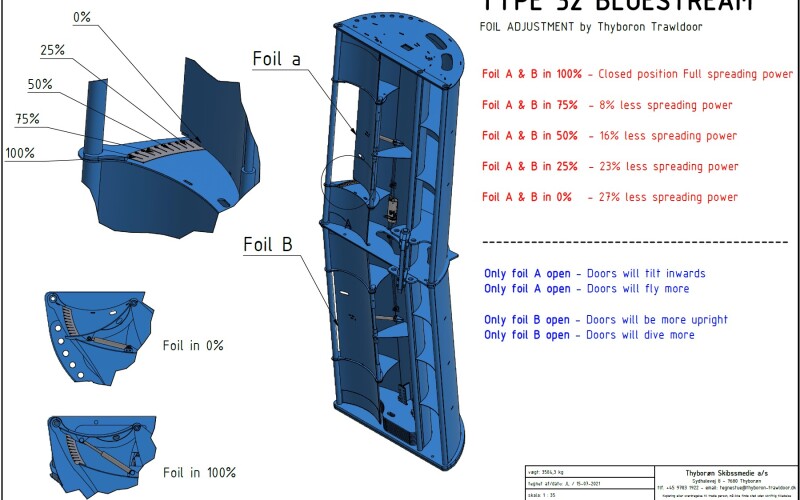
From the wheelhouse, the captain can utilize a number of features on the Thyborøn doors that can improve productivity and reduce bycatch. “From the software, you can increase or decrease the spread,” says Andreassen. “In Alaska during the B Season, the pollock boats are fishing in deep water with more wire and therefore need less power from the doors. In the A Season, they fish in shallower water and need all the spread they can get.”
Andreassen points out that through the software, the doors can be maintained at a constant depth. “With auto-depth option, you push a button, and the doors will stay in place. They can be controlled together or independently so that you can set them to keep the spread you want even if you are turning or in a cross current.”
By maintaining a desired spread even while turning in a cross current, Andreassen notes, fishermen can catch the same amount of fish in less time. “Even if you cut ten minutes off every tow, that adds up to fuel savings,” he says.
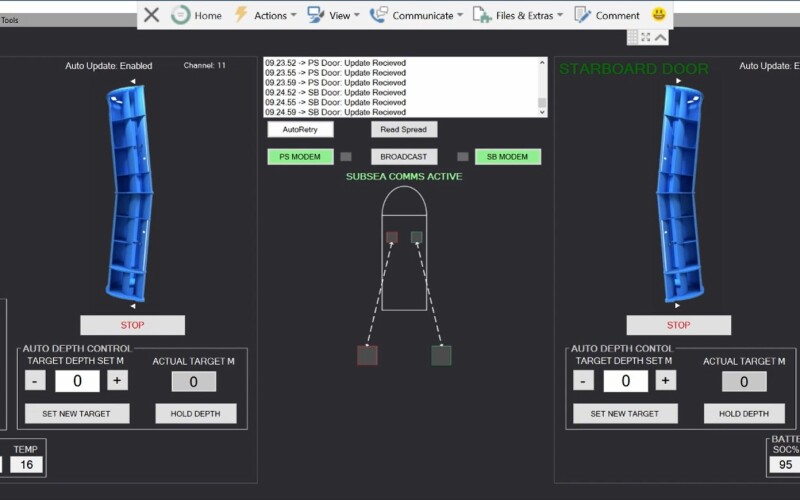
Another important feature of the doors may allow Alaskan fishermen to reduce bycatch. “Sometimes, when setting the net, you might pass through a layer of salmon. We have a shoot and a haul mode that reduces the spread and lets the net go down faster, so you get through that layer faster and the opening of the net is smaller. The same when hauling.”
The lithium battery in what Andreassen calls the “engine room” of the door can last for up to 40 hours of continuous use, he notes. “The charging system is back in the stern so that you can plug the charger right into the door. It can charge to 80 percent in approximately 1 hour, three hours to get to 100 percent.”
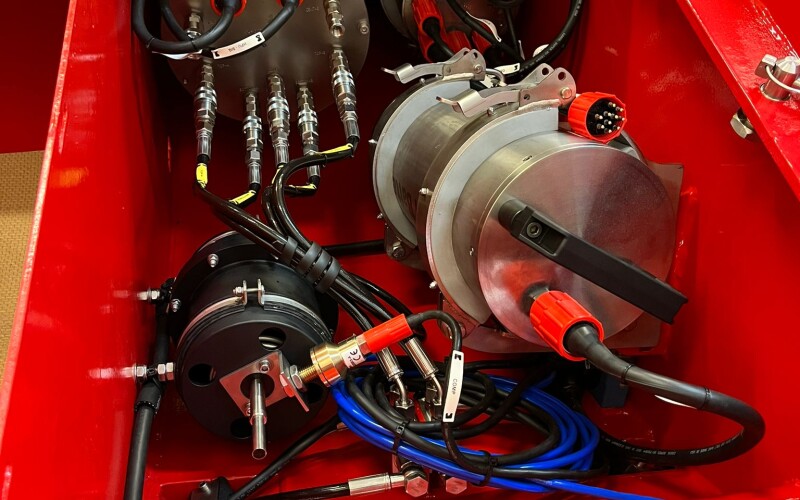
According to Andreassen, twelve boats are currently using the fully controllable 32 Bluestreams, and another three are using the 42 Bluestreams. “That’s the Kristin, Ocean Venture, and Beinur.” he says. Three more sets are in production just now for boats in Shetland, Norway, and Denmark.
Ola Hansson, skipper and part owner of the Kristin, can’t say enough good about the Bluestream 42. “We own a German-flagged pelagic trawler owned by Swedish fishermen who work onboard,” says Hansson. “We live outside Gothenburg on the island Donsö, (Sweden).”
At first, Hansson used 13-square meter Thyborøn Type 22 Trawldoors on the 174-foot Kristin, which was built at Karstensens shipyard in Skagen, Denmark in 2020.
“We were looking for even more powerful doors but have not the height enough in the gallows for higher doors,” says Hansson. “After discussion with Thyborøn they offer us to test their new model Type 42 and we invested in doors, bottom parts, and software for controlling the doors. We have now 12-square meter doors, no problem to handle the doors due to height and have much more spread efficiency and can use a bigger trawl with bigger volume and cover more water and bottom volume.”
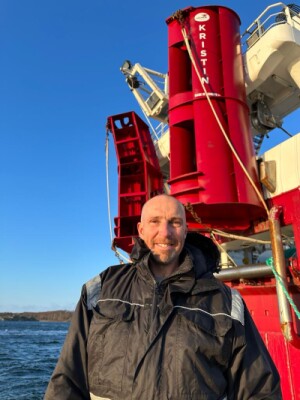
Hansson has become a big fan of the auto-depth feature. “I like that we now have doors we really can steer,” he says. “When we fish shallow or the current has an impact on the gear we use the auto-depth mode, and both doors really kept the chosen depth. We get good spread, and the trawl stays in good shape.”
Hansson adds that when trawling in manual mode, and not adjusting the foils very much, the batteries still had 33 percent charge after 52 hours. “In combination manual and auto-depth we used 50 percent of the capacity in 30 hours, and it’s easy to recharge the doors when bringing in the catch.”
The only challenge Hansson reports was on the maiden voyage with the test doors. “We were fishing in shallow water, 25 to 30 meters, but with the support and effort from Thyborøn Trawldoors together with the crew, we tested and adjusted until we found out how to handle the doors.” Since then he has had no issues.
“Our overall experience with Thyborøn Type 42 doors after using them in four different fisheries, from shallow to deeper water is very positive,” says Hansson. “And the communication between vessel and doors work well even when we have doors close to surface.”
“Maybe you think I’m boosting the doors and people from Thyborøn a little too much,” he said, “but we are quite satisfied with the product they deliver and always have been.”
Andreassen believes the controllable doors are finally ready for the Alaska fishery and is slowly sounding out the fleet. “We will eventually have a local technician we can work with in Dutch (Harbor). And if vessels have Starlink we can get into the system from home and see what is going on if there is a problem,” he says.
“We already sold a pair to a vessel in West Africa, so we are ready for a more distant market.”
